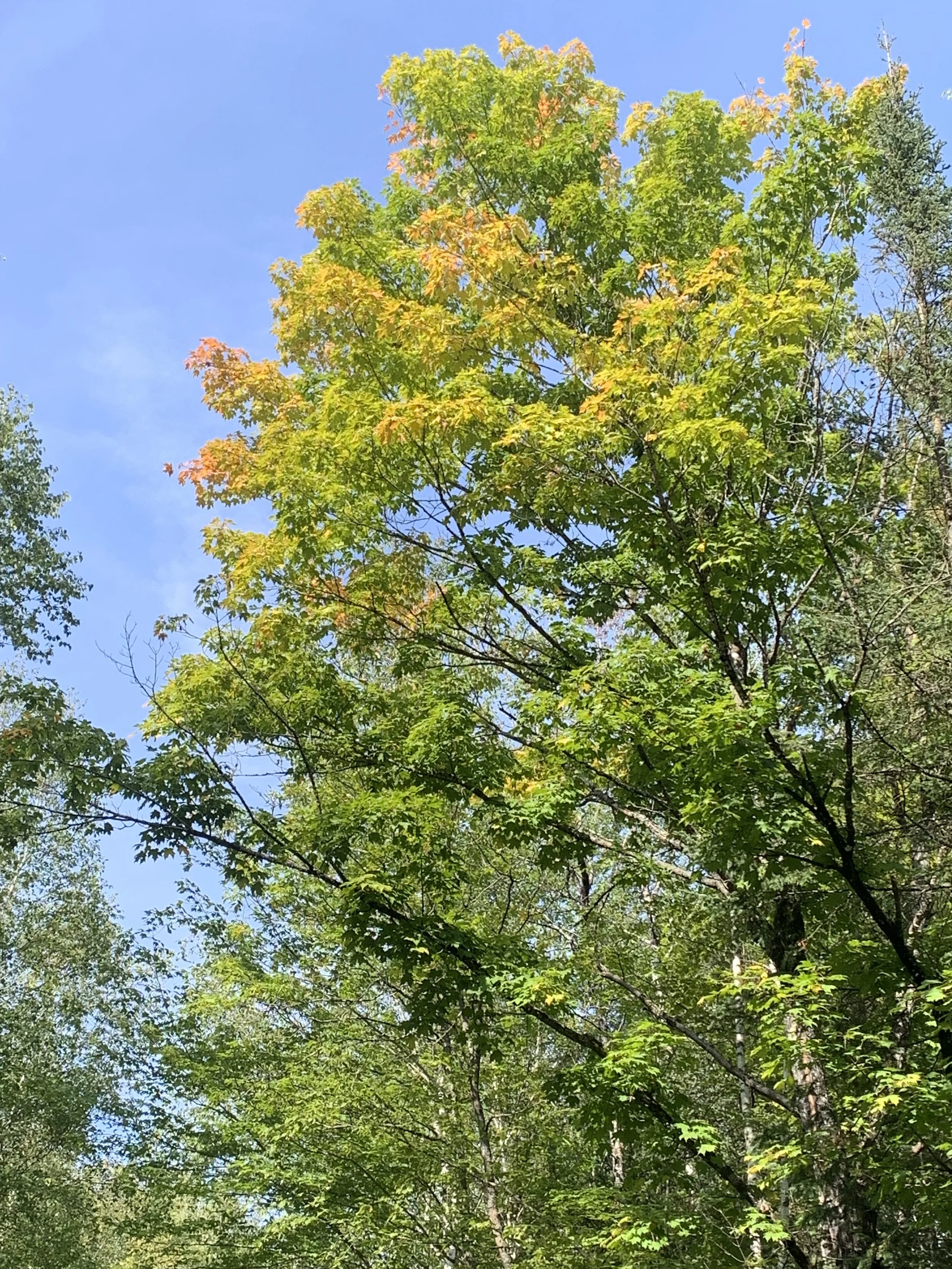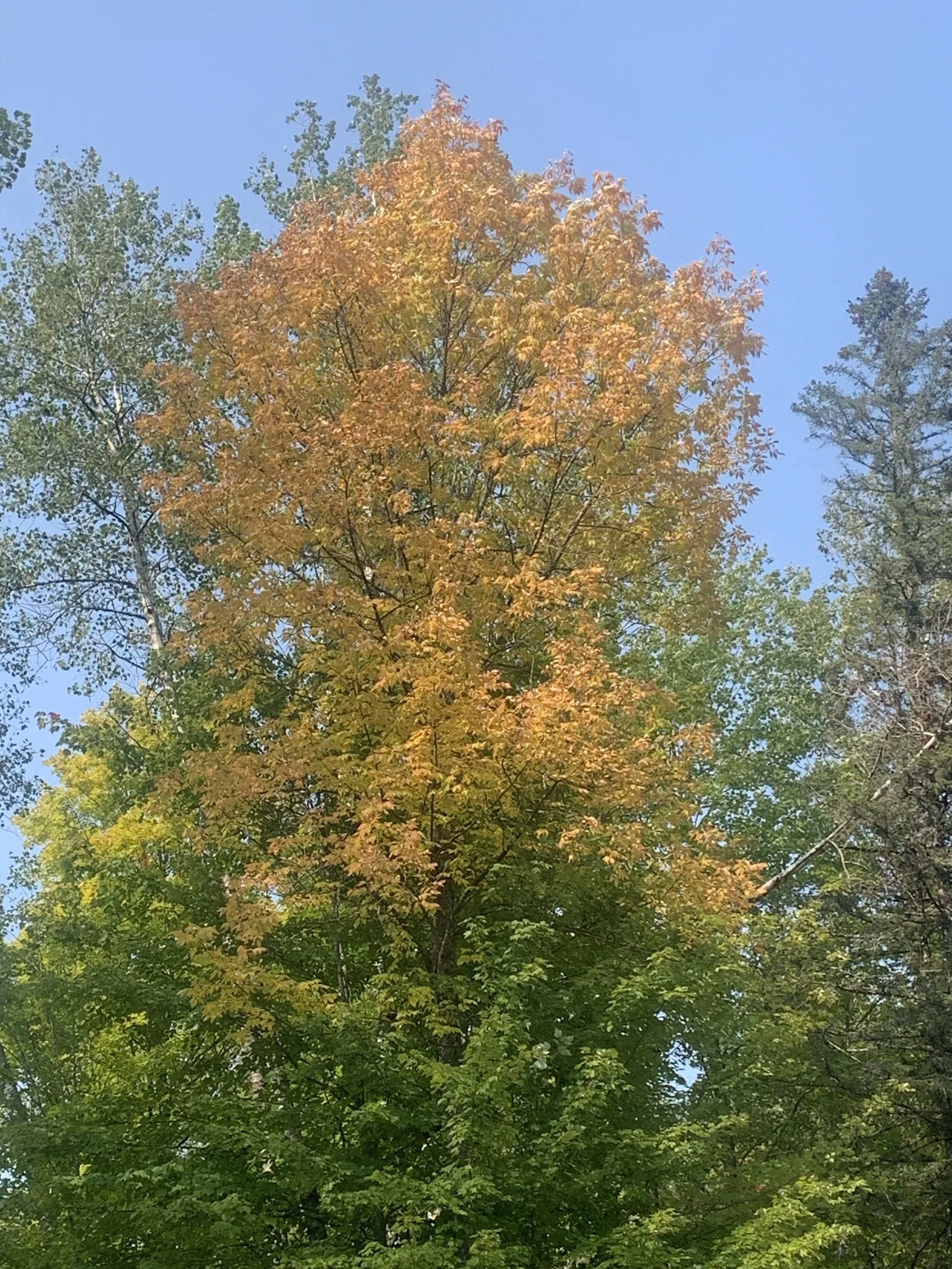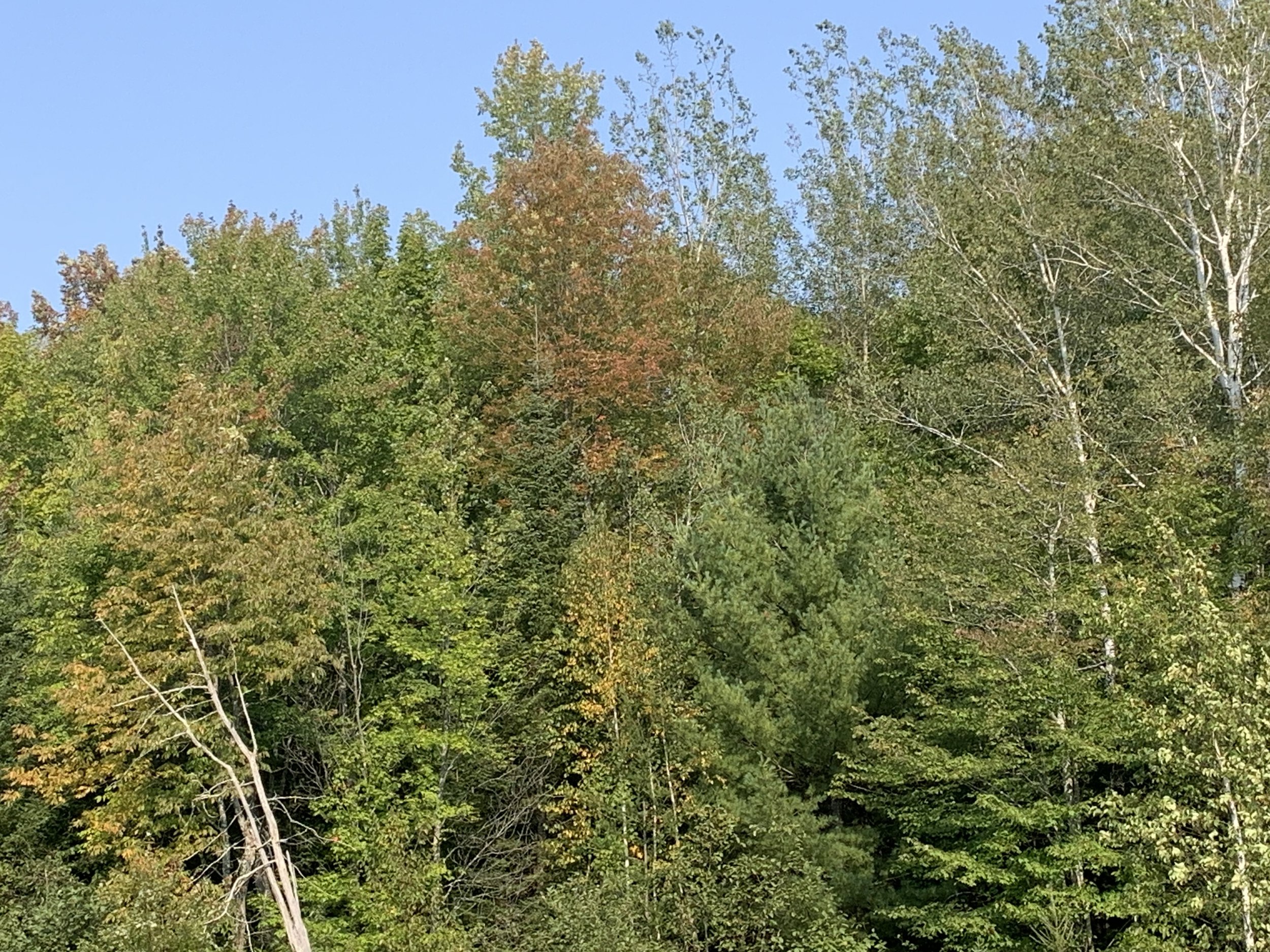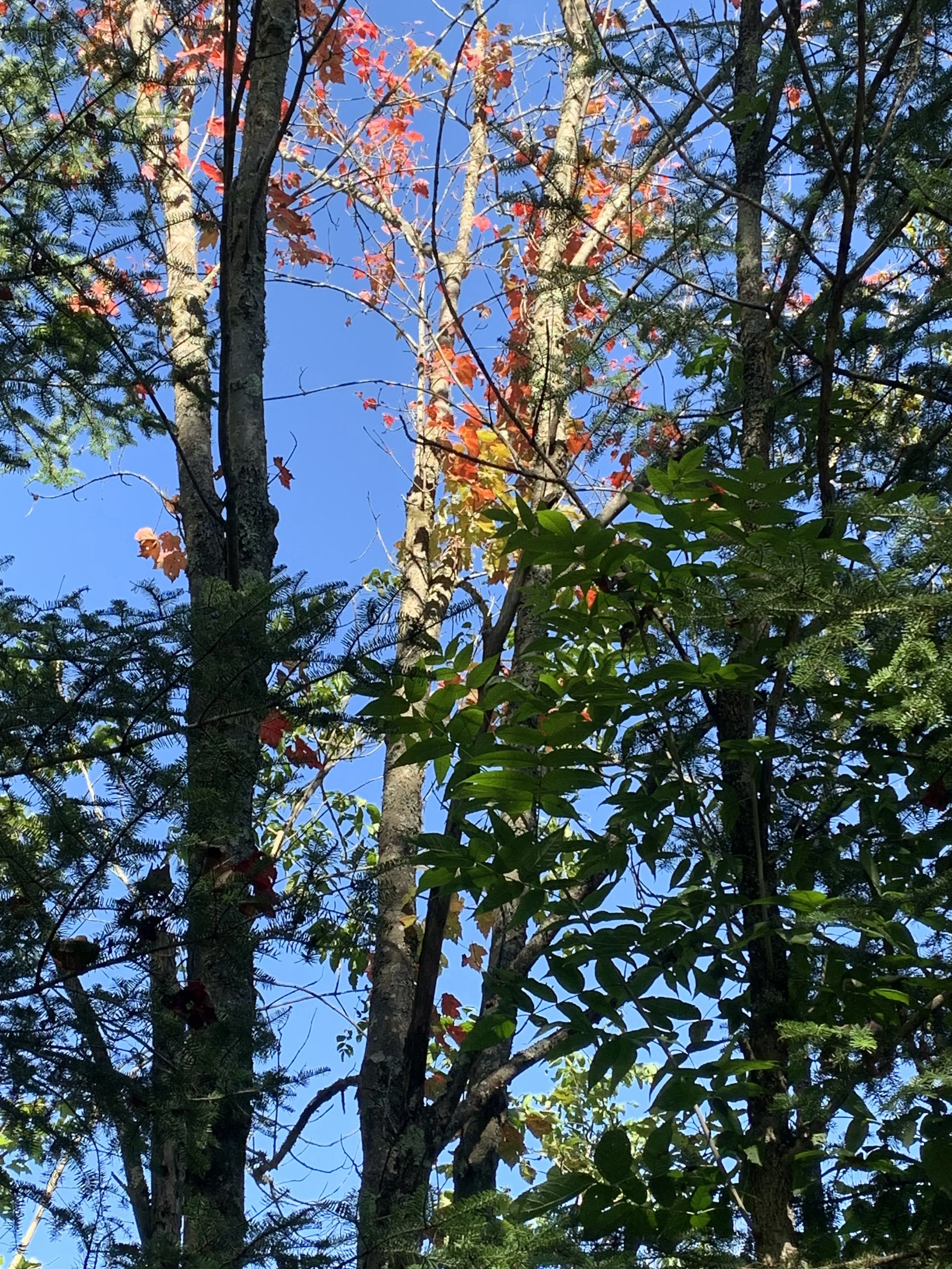What I did on my summer “vacation.”
Forest for the Trees
Whose woods these are....
….I have no idea.
They surround our North Woods cottage, technically our four acres. But no one can possibly know them much less own them. Creatures--seen and unseen--amble and flit among them. The birds are more apparent from their music and an occasional flicker of leaves. My eyes can take in hundreds of trees in one scan, all part—as some scientists maintain—of a single organism. The forest is steady but ever changing. Old timers fall. The weather and the critters work their magic, creating the soil to feed the young upstarts.
Transplant any one of these trees to a city park or suburban yard and it will become a different creature, a man-spreading, elbow-throwing space-hog that provides enough shade to host a summer picnic. But here, crowded like commuters on a New York City subway, there is nowhere to go but up. So pines, poplars, maples and birches stretch tall into the canopy, their leaves vying for a share of the precious sunlight.
Along the shore of the nearby lake, the individuals blend into a wall of lush greens. But a few Eastern White Pines tower above the canopy to claim your attention. One has become a favorite—my tree—an icon suggesting both beauty and survival.
It is in dense forest so I can see it only from a kayak on the lake. It commands the shoreline, rising above the scrim of foliage to claim a space for its spot against the clear sky. It wears its years with pride: trunk is straight and true. But that pillar supports bare snarled limbs as well as with branches exploding into a swell of delicate needles that ripple in the slightest breeze. Years both lean and abundant shared on a single trunk, the spare and the vibrant sprouting from a single set of roots.
Industrial Sludge
It apparently has become a fine time to hate the wealthy. No more Robin Leach fawning over the yachted and mansioned Lifestyles of the Rich and Famous. In Downton Abbey, the posh Crawley’s have scarfed down their last slice of treacle tart.
Today, we prefer to chuckle and gasp at the clueless heiresses and conniving tech bros of The White Lotus and hate-watch the siliconed and Botoxed Real Housewives, who continue their steady, Jimmy-Chooed march to all corners of the globe.
Succession gave us the chance to eye-roll our way through the travails of Murdoch-esque siblings as they jet-setted among the new media moguls, trying to secure their share of the new media landscape. And now the BBC and HBO-produced Industry—now it its third season—allows us to gawk at aspiring masters and mistresses of the universe as they scratch their way into the one percent.
The whippersnappers of Industry keep their eyes on the Big Board.
They are an interesting lot, these youngsters. Some are children of billionaires and ambassadors. Others are working-class strivers. They arrive at the London investment firm Pierpoint & Co. with a mandate worthy of Survivor or Squid Game: "In six months, half of you will be gone," Prove yourselves worthy. Some do it by cheerfully going on latte runs. Others simply endure the abuse of partners and clients, awaiting their lucky break in exchange-traded derivatives. Off the clock, the booze flows and the cocaine blows, and various sexual couplings and uncouplings set the stage for feuds and allegiances to come.
While they definitely have a flair for sensational plot twists, showrunners Konrad Kay and Mickey Down know the world of The City intimately. Both worked in finance before trying their hand at screenwriting, and Industry is ripe with financial jargon. In fact, Down told Time magazine that, “We forget that actually the majority of the audience has absolutely no idea what any of this terminology, plus all the British slang, means. It’s a miracle that people are able to follow it at all.” But the miracle is that the actors ripple through it and still create cracking good stories and characters. Even when one character asks ‘What’s the level of one-year Euro swap in 500K DVO1,” you’re on pins and needles awaiting the answer.
Salvage the Bones
Jesmyn Ward
A quick scan of the New York Times Book Review's best books of the (almost) past quarter-century reveals a handful of authors with more than one book represented. But even in that elite group, Jesmyn Ward stands out. Nearly every book she has written in her young career is on the list: Two novels--Sing, Unburied, Sing (2018), and Salvage the Bones (2011)--and a collection of biographical essays--Men We Reaped (2017).
Dive into the world of Salvage the Bones and you'll understand why. Its portrait of a hardscrabble existence in the Mississippi Gulf Coast is unsparing but loving, brutal but tender. Esch, the teenage narrator, is pregnant and consumed with lust for the father, who spurns her. Her brother Skeeter raises pit bulls with almost maternal care, but intends them for the brutality of the dog fighting pit. Their value is in their savagery.
The novel’s intimacy is earned. Ward grew up on the Mississippi Gulf Coast and still lives there. Its final chapters describe the harrowing arrival and aftermath of Hurricane Katrina with furious language and riveting suspense. It rings true because Ward lived through it herself, and every sentence shows it. My most compelling read of this summer.
Before the Fall
Two hundred twelve miles north of where I write this, the change has started, the summer green incrementally fading into golds and ambers while outliers—red maples—impatiently drop splashes of crimson onto the forest floor. (Click on any image to see it full size.)
Tis the Season
Looking for a soundtrack for the cool air and waning light? None better than this. From Cannonball Adderley’s Blue Note album, Somethin’ Else, recorded March 9, 1958. Featuring Adderley on alto sax, Miles Davis on trumpet, Hank Jones on piano, Sam Jones on bass and a very subdued Art Blakey on drums. Enjoy. See you next week.











